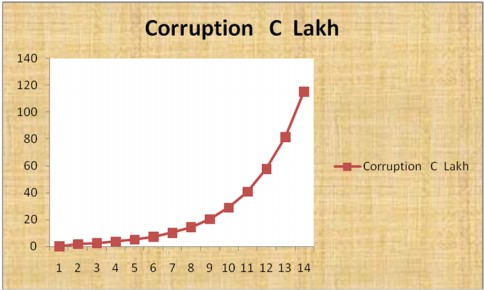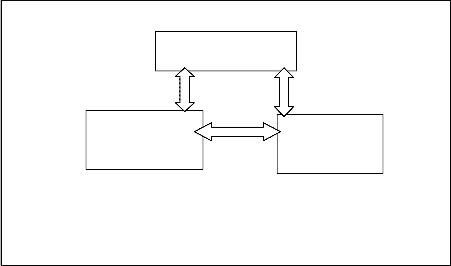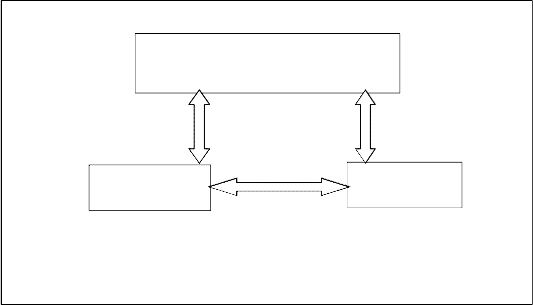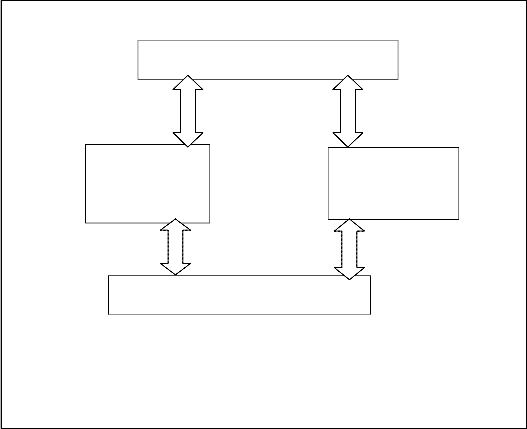International Journal of Scientific & Engineering Research, Volume 4, Issue 7, July-2013
ISSN 2229-5518
2303
SAYAJI RASTUM WAYKAR
(Research Scholar, JJT, University, Rajasthan) Assistant Professor, Department of Mathematics Yashwantrao Chavan Mahavidyalaya, Halkarni
Tal: Chandgad, Dist: Kolhapur, Maharashtra (India).
In this paper, we have studied on the topic of ‘Corruption’. Also, I will try to find or study the effect of corruption on the Development of the society or country of the world. Therefore, how find the solution of the problem of corruption will be destroyed completely from the society. We have observed that the Development of the country depends upon Corruption. That is, when the Corruption increases, Development decreases automatically of any country of the world. Therefore, I will try to find the formula on the problem of ‘Relation between the Corruption and Development of any field of any country of the world’.
Also, I have to highlight the concept of ‘Application of Mathematical modeling in the interestin g problem “corruption” in every field of any country of the world. Also, Applied Mathematics focuses on the formulation and study of Mathematical Models .Thus the activity of Applied Mathematics is vitally connected with Research in Pure Mathematics. Now we convert this
areal world problem to mathematics problem and find some formulae on it such as Mathematical Corruption Growth formula, Mathematical Constant corruption level formula and Mathematical decay of corruption formula.
Today, in India the problem of corruptions have in each and every field. So I will try to study on the topic of ‘corruption’ and it gets a ‘Mathematical Corruption Model’ and also I have found some formulae on it. There are as,
ii) Mathematical Constant Corruption level formula: C =![]() , when Ҝ = 0
, when Ҝ = 0
IJSER © 2013 http://www.ijser.org
International Journal of Scientific & Engineering Research, Volume 4, Issue 7, July-2013
ISSN 2229-5518
2304
![]()
From (i), we will find the quantity of corruption in each and every field in our country or world. From (ii), Constant corruption will always in every country at any time.
From (iii), we will try to reduce the corruption to the Mathematical Constant corruption level. From (iv) and (v), we will find the actual Development of any field with related Corruption.
We have to highlight the problem of ‘corruption’ in front of our country or the world. Because,
present days, every person in society is suffering from corruption in every field such as Government offices, Educational offices, politicians and Judiciary and its related officers of various courts of our country and others etc. So that corruptions have removed completely from the society. Therefore, we will try to find the quantity of corruption in our country at any time. Also, I have observed that there are many Corruption Ghotales are open such as CAG ghotala, Adarsh ghotala, 2G-Spectrum ghotala, Rashtrakul krida ghotala, Bhoferse ghotala,
District Banks ghotala, Co-operative factories and Institute ghotala, Development of Airport and
Electricity ghotala, Jal sichan ghotala and etc. Therefore we have observed that there will be a big problem in front of our Country. So, we will try to find the solution for reducing the growth of corruption from the society as well as in all other field of our country or world.

We have to use mathematical modeling. Mathematical modeling means that it is the relation between rest of world and mathematics world. That is translation from a real world problem to mathematics problem.
Real world
Problem
Conclusion
Make
Assumptions
Mathematical
Model
Mathematical
Result
That is Mathematical model building involves imagination and skills.
IJSER © 2013 http://www.ijser.org
International Journal of Scientific & Engineering Research, Volume 4, Issue 7, July-2013
ISSN 2229-5518
2305
The spread of primary education, secondary education, higher secondary education and Higher education in society is at the foundation of success in Countries that are latecomers to development. In the quest for development, primary education and secondary education are absolutely essential because it creates the base. But higher education is just as important, for it provides the cutting edge. And universities are the life-blood of higher education. Islands of excellence in professional education, such as Indian Institutes of Technology and Indian Institutes of Management are valuable complements but cannot be substitutes for universities which provide educational opportunities for people at large.
There can be no doubt that higher education has made a significant contribution to economic development, social progress and political democracy in independent India. It is a source of dynamism for the economy. It has created social opportunities for people. It has fostered the vibrant democracy in our polity. It has provided a beginning for the creation of a knowledge society. But it would be a mistake to focus on its strengths alone. It has weaknesses that are a cause for serious concern. Also, there are more than 350 universities and more than 17,700 undergraduate colleges. Of these, a mere 200 colleges are autonomous and a lot of primary and secondary Institutes are in our Country. Overall, we have observed that the education in India is worrisome because there are some reasons one is a lot of Corruption and second is quality and research are very weak as compare to the world. Quality in primary and secondary is very weak that is, base is very weak then what about higher education? Also research in higher education has a large number of quantity but it will not in use or only less in use. There is a rea l fact in higher education in our Country.
Shri Shivaji Vishwastha Shikshan Sanstha was established on 1 April, 1983 at Daulatnagar. Suppose, the collection of fund of SSVS was Rs.100000/- per year. Here, I use seven steps of Mathematical Modelling process. First we consider there was no corruption at initial stage that is 1 April, 1983. But after one year period, the corruption was one percentage of initial Sanstha fund. Therefore C=0.01 lakh rupees when t=1 year on April, 1984.
Therefore, we use the Mathematical Corruption Growth formula, we have![]()
![]()
![]()
0.01=
IJSER © 2013 http://www.ijser.org
International Journal of Scientific & Engineering Research, Volume 4, Issue 7, July-2013
ISSN 2229-5518
2306
But here we take Ҝ=0, we have![]()
![]()
0.01=![]()
![]()
0.01=![]()
![]() = 0.01
= 0.01
Putting in equation (i), we get![]()
C = 0.01 ![]() ------------------- (ii)
------------------- (ii)
Then next one year that is April, 1985, the corruption was double of old that is C = 0.02 lakh.
Therefore C = 0.02 lakh when t=2 years.
Therefore from (ii), we have![]()
![]()
![]()
![]()
0.02 = 0.01 ![]()
![]() =
=
![]()
![]()
= ![]()
Putting this value in equation (ii), we have![]()
C = 0.01![]() ------------------- (iii)
------------------- (iii)
Note that in the both the cases of the above, we take E-virus constant Ҝ =0 for finding the basement formula and the equation (iii) is known as Mathematical Model Base Corruption with related time formula.
Now we will try to find corruption in next each year period as of the following: Therefore when t=3 years from base then what was C=? at April, 1986![]()
From equation (iii), C = 0.01![]()
![]()
![]()
C = 0.01![]()
![]()
C = 0.01
IJSER © 2013 http://www.ijser.org
International Journal of Scientific & Engineering Research, Volume 4, Issue 7, July-2013
ISSN 2229-5518
2307
![]()
C = 0.01![]() 2.82715
2.82715![]()
When t=4 years then what was C=? at April, 1987![]()
![]()
From equation (iii), C = 0.01![]()
![]()
C = 0.01![]()
C = 0.01![]() 3.99759
3.99759![]()
When t=5 years then what was C=? at April, 1988![]()
![]()
From equation (iii), C = 0.01![]()
![]()
C = 0.01![]()
C = 0.01![]() 5.65259
5.65259![]()
When t=6 years then what was C=? at April, 1989![]()
![]()
From equation (iii), C = 0.01![]()
![]()
C = 0.01![]()
C = 0.01![]() 7.99276
7.99276![]()
When t=7 years then what was C=? at April, 1990![]()
![]()
From equation (iii), C = 0.01![]()
![]()
C = 0.01![]()
C = 0.01![]() 11.30176
11.30176
IJSER © 2013 http://www.ijser.org
International Journal of Scientific & Engineering Research, Volume 4, Issue 7, July-2013
ISSN 2229-5518
2308
![]()
When t=8 years then what was C=? at April, 1991![]()
![]()
From equation (iii), C = 0.01![]()
![]()
C = 0.01![]()
C = 0.01![]() 15.98069
15.98069![]()
When t=9 years then what was C=? at April, 1992![]()
![]()
From equation (iii), C = 0.01![]()
![]()
C = 0.01![]()
C = 0.01![]() 22.5967
22.5967![]()
When t=10 years then what was C=? at April, 1993![]()
![]()
From equation (iii), C = 0.01![]()
![]()
C = 0.01![]()
C = 0.01![]() 31.95173
31.95173![]()
When t=11 years then what was C=? at April, 1994![]()
![]()
From equation (iii), C = 0.01![]()
![]()
C = 0.01![]()
C = 0.01![]() 45.17975
45.17975![]()
When t=12 years then what was C=? at April, 1995
IJSER © 2013 http://www.ijser.org
International Journal of Scientific & Engineering Research, Volume 4, Issue 7, July-2013
ISSN 2229-5518
2309
![]()
![]()
From equation (iii), C = 0.01![]()
![]()
C = 0.01![]()
C = 0.01![]() 63.88417
63.88417![]()
When t=13 years then what was C=? at April, 1996![]()
![]()
From equation (iii), C = 0.01![]()
![]()
C = 0.01![]()
C = 0.01![]() 90.33222
90.33222![]()
When t=14 years then what was C=? at April, 1997![]()
![]()
From equation (iii), C = 0.01![]()
![]()
C = 0.01![]()
C = 0.01![]() 127.72976
127.72976![]()
When t=15 years then what was C=? at April, 1998![]()
![]()
From equation (iii), C = 0.01![]()
![]()
C = 0.01![]()
C = 0.01![]() 180.60988
180.60988![]()
When t=16 years then what was C=? at April, 1999![]()
![]()
From equation (iii), C = 0.01![]()
![]()
C = 0.01
IJSER © 2013 http://www.ijser.org
International Journal of Scientific & Engineering Research, Volume 4, Issue 7, July-2013
ISSN 2229-5518
2310
![]()
C = 0.01![]() 255.38237
255.38237![]()
When t=17 years then what was C=? at April, 2000![]()
![]()
From equation (iii), C = 0.01![]()
![]()
C = 0.01![]()
C = 0.01![]() 361.11067
361.11067![]()
When t=18 years then what was C=? at April, 2001![]()
![]()
From equation (iii), C = 0.01![]()
![]()
C = 0.01![]()
C = 0.01![]() 510.61049
510.61049![]()
When t=19 years then what was C=? at April, 2002![]()
![]()
From equation (iii), C = 0.01![]()
![]()
C = 0.01![]()
C = 0.01![]() 722.00323
722.00323![]()
When t=20 years then what was C=? at April, 2003![]()
![]()
From equation (iii), C = 0.01![]()
![]()
C = 0.01![]()
C = 0.01![]() 1020.91257
1020.91257![]()
IJSER © 2013 http://www.ijser.org
International Journal of Scientific & Engineering Research, Volume 4, Issue 7, July-2013
ISSN 2229-5518
2311
When t=21 years then what was C=? at April, 2004![]()
![]()
From equation (iii), C = 0.01![]()
![]()
C = 0.01![]()
C = 0.01![]() 1443.57037
1443.57037![]()
When t=22 years then what was C=? at April, 2005![]()
![]()
From equation (iii), C = 0.01![]()
![]()
C = 0.01![]()
C = 0.01![]() 2041.2085
2041.2085![]()
When t=23 years then what was C=? at April, 2006![]()
![]()
From equation (iii), C = 0.01![]()
![]()
C = 0.01![]()
C = 0.01![]() 2886.26882
2886.26882![]()
When t=24 years then what was C=? at April, 2007![]()
![]()
From equation (iii), C = 0.01![]()
![]()
C = 0.01![]()
C = 0.01![]() 4081.18411
4081.18411![]()
When t=25 years then what was C=? at April, 2008![]()
![]()
From equation (iii), C = 0.01
IJSER © 2013 http://www.ijser.org
International Journal of Scientific & Engineering Research, Volume 4, Issue 7, July-2013
ISSN 2229-5518
2312
![]()
![]()
C = 0.01![]()
C = 0.01![]() 5770.79433
5770.79433![]()
When t=26 years then what was C=? at April, 2009![]()
![]()
From equation (iii), C = 0.01![]()
![]()
C = 0.01![]()
C = 0.01![]() 8159.90318
8159.90318![]()
When t=27 years then what was C=? at April, 2010![]()
![]()
From equation (iii), C = 0.01![]()
![]()
C = 0.01![]()
C = 0.01![]() 11538.1031
11538.1031![]()
Here we have observed that for using Mathematical Modelling that means we translate the real world problem ‘Corruption’ to Mathematics problem. First we take a real world problem
‘Corruption’ then we make Mathematical Corruption Model and we get Mathematical solution
then when we compare the Mathematical Result to reality and if it is true then we get the really mathematical result of the real world problem.
The above result shows that the Mathematical Corruption in the Shri Shivaji Vishwastha Shikshan Sanstha, Daulatnagar is Rs. 115.38103 lakh. Similarly, we can find the Mathematical corruption in the other Educational Institutes. So we say that the problem of Corruption in the Educational Institutes will be worrisome in our Country. When the corruption increases in the educational Institutes that time development decreases that means not given any facilities or weak to the students that is basic, physical and mental. Also education means the all around development of students. Therefore we say that the aim of education in our country will not
succeed.
IJSER © 2013 http://www.ijser.org
International Journal of Scientific & Engineering Research, Volume 4, Issue 7, July-2013
ISSN 2229-5518
2313
Swami Vivekananda said, ‘Education is manifestation of perfection in which already with in a man’.
Time t Years | Corruption C Lakh |
1 | 0.02 |
2 | 0.02827 |
3 | 0.03998 |
4 | 0.0565259 |
5 | 0.07993 |
6 | 0.11302 |
7 | 0.15981 |
8 | 0.22597 |
9 | 0.31952 |
10 | 0.4517975 |
11 | 0.6388417 |
12 | 0.9033222 |
13 | 1.2772976 |

IJSER © 2013 http://www.ijser.org
International Journal of Scientific & Engineering Research, Volume 4, Issue 7, July-2013
ISSN 2229-5518
2314
Here from the graph and table: 1 and table: 2 we have observed that the mathematical growth of corruption increased in every year. Also we assume that very small value but the result will be a big value. This shows that from the mathematical modeling cycle, the result will get a positive corruption and It is effected on the Development of the Educational Institutions. If the corruption increases then the development of the educational Institutions decreases.
There are many government offices from Grampanchayat –gramsevak, Talathi office. In Taluka place- Panchayat Samati office, Tahasildar office, NagarParshad office, Electrical Board office, BSNL office, Taluka Police offices and Judiciary (Diwani Court) offices. In district place- Zilha Parishad office, Municipal Corporation, Civil Hospital, District Police office, Samajkalyan office, Employment office and District Court office and etc. In state place-Director Offices in different fields such as Education and etc. and also sectionwise offices such as Joint Director of Higher Education and etc. and Ministers offices of different fields. So there are many government offices in our Country. Therefore we have observed that the working process with related Corruption of the above different government offices are same. Here we consider one illustration of working process with related Corruption in the government different offices.
There are four classes of Servants working in the government (any) office which have Chief, Assistant, Head Clerk, Senior Clerk, Junior Clerk and Peon. They are working from 11.00 am to
05.00 pm or 06.00 pm. daily.
Principal
ACS COLLEGE
Real world problem
of a Teacher
Office Superident COLLEGE
IJSER © 2013 http://www.ijser.org
International Journal of Scientific & Engineering Research, Volume 4, Issue 7, July-2013
ISSN 2229-5518
2315
From Model-1, a Teacher who is working in the post of Assistant Professor to the Arts, Commerce and Science College, Daulatnagar. By using seven steps Mathematical Modellin g Cycle, we have the Real world problem is that ‘for removing break in service’. That means the Teacher was working to the previous college from 01 December, 1993 to 16 June, 1996 and then joins this college from 10 August, 1996. So there was break between two university colleges that is from 17 June, 1996 to 9 August, 1996. Therefore we make Mathematical working College Model for solving the problem ‘removing break in service’ of a particular solution.
From Model-1, It shows that a Teacher complains to the Principal for solving his real world problem for removing break in service then the Principal suggests to office superident about his problem. Then office superident call to teacher for making a proposal of a problem and this proposal sent to the Joint director of Higher Education office on date July, 2004 for solving his problem. Now we consider Model-2 that is Mathematical working of Joint director of Higher
education model. It is as follows:
Joint Director of Higher Education
Divisional Office
College Office
(Senior)
(JD OFFICE) Senior Clerk
From Model-2, It shows that when they received the proposal of a Teacher from Arts, Commerce and Science College, Daulatnagar. Then they did not take decision on the proposal up to the three years that is June, 2007. Further the teacher contacted to the JD office through RTI act and then the JD office replied to him for solving the problem and sending his proposal with the recommendations to the Director of Higher Education office for the necessary action
on it.
IJSER © 2013 http://www.ijser.org
International Journal of Scientific & Engineering Research, Volume 4, Issue 7, July-2013
ISSN 2229-5518
2316
Now we consider the Model-3 that is Mathematical working of Director of Higher Education model. The DHE office received the recommended proposal of a Teacher on date December,
2007 for the necessary action on it. After six months the Teacher contacted to DHE office for his problem then the office replied him that ‘your problem will solve after one month’. Again after six months he contacted to DHE office then the answer will be same of previous.
Director of Higher Education
(OFFICE)
Joint Director of Higher Education (OFFICE)
Administrative
Officer
(DHE OFFICE)
Junior Clerk (related section) (DHE OFFICE)
Every time a Teacher will use a Mathematical Modelling cycle such as when he contacted to DHE office through RTI act then the DHE office contacted to JD office and then JD office contacted to College office and then the College office calls to a teacher about his problems query. This is a one Mathematical Modeling cycle of one year period. Then the teache r completing his query then the College office sent his query to JD office then the JD office sent same to DHE office for necessary action on it. This is a second Mathematical Modelling cycle of one year period again. Similarly Third and Fourth Mathematical Modelling cycle of each one
year period that means up to May, 2011 then lastly they solved his problem when he gave them
a bribe. We have observed that when we look of the above problem, ‘without a bribe, the problems (of any people) will not solve’. So we say that the Mathematical Model for working
process will be same to all government offices in our Country.
IJSER © 2013 http://www.ijser.org
International Journal of Scientific & Engineering Research, Volume 4, Issue 7, July-2013
ISSN 2229-5518
2317
I have observed and concluded that Mathematical modeling is a problem-solving process that is useful when the complexity of a setting or the nature of a question makes directly deducing an answer difficult or impossible. The adoption of simplifying assumptions often makes it possible to approach an analog of the problem in a plainer and less cluttered setting. One can decide if the answer in the simplified setting is useful, or if the assumptions need to be revisited. Also we have observed that the above two illustrations have used the mathematical modeling cycle.
That means the Real world problem ‘corruption in the Educational Institutes as well as in the Different government offices’ convert to the Mathematics problem. Then we get mathematical solution that is mathematical result when we compare this result with the reality and then we have seen that when Corruption increases, the Development decreases automatically of any fields of any country of the world. Also we have seen that the mathematically model for working process in the different government offices are very weak because a lot of corruption in it. If the working process in the government offices will transparent, sincere, no corruption and active then at that time our or any Country (of the world) will become very strong in the world.
Mathematical model building involves imagination and skill. The importance of imagination in problem solving has been recognized frequently. For instance, Einstein said, “only intuition, resting in sympathetic understanding can lead to insight”. Similarly, Poincare in 1913 noted that “It is by logic that we prove but by intuition that we discover” (Root-Bernstein and Root- Bernstein, 1999).
[1] Andriole SJ (1983) Handbook of problem solving: An analytic methodology Princeton, NJ: Petrocelli Books.
[2] Bender EA (1978) An introduction to mathematical modeling New York: John Wiley and
Sons.
[3] Giordano FR, Weir MD, Fox, WP (2002) A first course in mathematical modeling ![]() Ed
Ed
Pacific Grove, CA: Brooks/cole.
[4] Gershenfeld N (1999) The nature of mathematical modeling Cambridge, Ma: Cambridge
University press.
IJSER © 2013 http://www.ijser.org
International Journal of Scientific & Engineering Research, Volume 4, Issue 7, July-2013
ISSN 2229-5518
2318
[5] Maki DP, Thompson M (1973) Mathematical models and applications Englewood cliffs, NJ: Prentice-Hall.
[6] Meyer WJ (1984) concepts of mathematical modeling New York, NY: McGraw Hill.
[7] Root-Bernstein R, Root-Bernstein M (1999) Sparks of genius Boston, MA: Houghton Mifflin. [8] Schoenfeld A. H. (1994). Mathematical Thinking and Problem Solving. Hillsdale: Erlbaum.
[9] Shulman, L. (1986). Those who understand: Knowledge growth in teaching. Educational
Researcher, 15(2), 4-14.
[10] Verschaffel,L. / Greer, B. / DeCorte, E. (2000) Making sense of world Problems Lisse: Swets
& Zeitlinger.
[11] Zafar Ashan, Differential equations and their applications, prentice hall of India, New Delhi
(1999).
IJSER © 2013 http://www.ijser.org